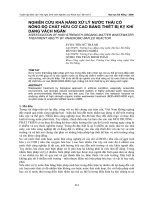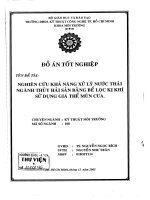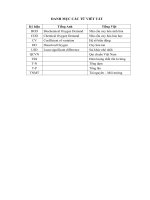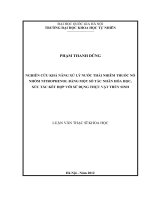NGHIÊN CỨU KHẢ NĂNG XỬ LÝ NƯỚC CHO BỂ NUÔI CÁ CẢNH NGOÀI TRỜI BẰNG CÔNG NGHỆ BÃI LỌC TRỒNG CÂY
Bạn đang xem bản rút gọn của tài liệu. Xem và tải ngay bản đầy đủ của tài liệu tại đây (347.23 KB, 5 trang )
<span class='text_page_counter'>(1)</span><div class='page_container' data-page=1>
<b>RESEARCH WATER TREATMENT ABILITY OF OUTDOOR AQUARIUM </b>
<b>BY CONSTRUCTED WETLANDS </b>
<b>Vi Thi Mai Huong</b><i><b>* </b></i>
<i>University of Technology - TNU</i>
SUMMARY
This report presents the initial results about capacity of using constructed wetlands to treat water of
outdoor aquarium. The experimental model includes an outdoor aquarium (0.7 x 0.3 x 0.4)m, a
constructed wetland (0.67 x 0.25 x 0.38)m, a wastewater tank (0.4 x 0.2 x 0.33)m. The model was
operated for 30 days, aquariums had 07 goldfish, 5-7 cm long. Water flow into constructed
wetland was 12 l/d and water retention time was 1 day. The result indicated that fish was always
healthy, water in aquarium was maintained with good quality, reaching QCVN 38:2011/BTN&MT
on water quality regulation to protect aquatic life. The values of pH, DO, TSS, NH4+-N of water in
aquarium were 7.1-7.4; 5.2-5.9 mg/l; 16-27 mg/l; 0.61-0.76 mg/l respectively.
<i><b>Key words: Aquarium, aquarium water treatment, constructed wetlands, aquarium water filters, </b></i>
<i>outdoor aquariums</i>
INTRODUCTION*
Water filtration systems are essential for
aquariums. They have the function of
filtering, purifying water in the tank thanks to
the filter layer equipped in the filtration
systems. That will make water in aquarium
clean, oxygen-rich and creating a favorable
environment for fish to grow well. Aquarium
water filter systems on the market today are
quite diverse in types. In general, these
systems consist of three main mechanisms:
mechanical filtration, chemical filtration and
biological filtration. Filtration systems are
usually a combination of two mechanisms
including mechanical filtration and biological
filtration or a combination of all three
mechanisms mechanical filtration, chemical
filtration and biological filtration to ensure
system efficiency. Popular filter systems on
the market today such as Hang on back filter,
Sponge Filter, Overflow Filter, Canister
/external filter, Undergravel filter, Fluidized
bed Trickle Filter, Diatom filter… In these
systems, water is continuously pumped
through one or several layers of material
during the filter operation. When passing
of contaminant will be trapped on the surface
of the material. Small size particles, solutes
will be microorganisms that adhere to the
surface of the decomposing filter material,
transformed into simple or non-toxic
inorganics. As a result, the water in the
aquarium is cleaned. The advantage of these
systems is the ability to treat quite well with
the containants in the water, diverse designs,
beautiful, easy to install and use. But these
systems have many disadvantages. Those are
quickly clogged, often have to clean or
replace the filter materials. On the other hand,
water pumps must operate continuously
during filtration.
</div>
<span class='text_page_counter'>(2)</span><div class='page_container' data-page=2>
Aquaponics is a good example of constructed
wetland application in treating wastewater
from aquariums. This is a closed recirculation
system that combines aquaculture and
hydroponic farming [3]. The system includes
an aquarium, a constructed wetland (tree
planting tray) and an automatic circulating
water pump system. In the aquaponic system.
Water from fish tank containing fish waste is
pumped into the constructed wetland.
Pollutants are treated by sedimentation,
filtration through filter material, organic
matter decomposition, nitrification, nitrifying
reaction by microorganisms adhering to the
surface of filter materials and around the
roots. As a result, fish waste is transformed
into nutrients for plant growth. Water is
cleaned and returned to the aquarium.
Therefore, water can be re-used indefinitely,
just add the amount of evaporative losses and
no emission of wastewater to the environment
[3]. However, this system has the
disadvantage that the water retention time in
the filtering plant is short 20-30 minutes [3]
so it is not enough for microbial metabolism
to reduce the efficiency of the system. On the
other hand, the system only operates when the
pump is operated. In order to keep the system
running continuously, the pump must operate
continuously. This results in energy costs and
reduces the life of the pump. Therefore, the
study proposes a treatment system to
overcome the shortcomings of this system in
order to improve the applicability of the
constructed wetland in the treatment of
aquarium water is essential.
In Vietnam today, along with the
development of the national economy, the
living standard of people has been raised, the
spiritual demand is paid more attention. One
of the more popular types of entertainment is
the aquarium. Aquariums of various sizes can
be placed in the living room, courtyard or
garden of the family. It creates a beautiful,
lively landscape, expressing love for nature,
helping people relieve stress, fatigue in life.
However, one of the biggest difficulties for
aquarists is that water filters for aquariums
are often clogged, must be rinsed, replaced or
water change if not, water will be
contaminated causing fish to die. Therefore, it
cost a lot of money, time and effort during
aquarium. For small fish tanks placed in a
room, this work is not difficult, but with
larger outdoor fish tanks, high investment
costs and large tanks, it is a difficult and
costly task. Many outdoor aquariums after a
period of use did not work anymore.
Therefore, the research to find out a suitable
technology to treat wastewater of outdoor
aquarium to improve the disadvantages of
existing systems is very important
significance. On that basis, author selected the
<i>topic: “Research water treatment ability of </i>
<i>outdoor aquarium by constructed wetlands” </i>
to assess the possibility of applying
constructed wetlands in wastewater treatment
of outdoor aquariums. Beside, constructed
wetland can create a natural ecological
landscape for the aquarium.
MATERIAL AND METHOD RESEACH
<b>Design the experimental model </b>
</div>
<span class='text_page_counter'>(3)</span><div class='page_container' data-page=3>
<i><b>Figure 1. Diagram of the experimental model. (a): Diagram of experimental layout. (b): Diagram of </b></i>
<i>constructed wetland structure. </i>
<i>(Note: 1: Aquarium; 2:wastewater tank; 3: constructed wetland; 4: Flow control valve; 5: Water </i>
<i>collecting pine; 6: Flush valv; 7: pump) </i>
<b>Operated the experimental model </b>
<i>- Step 1: Fish breeding. Choose gold fish, </i>
5-7cm in length, 7 fish. Feed the fish twice
daily at 7am and 5.30pm with synthetic feeds
<i>exclusively for goldfish. - Step 2: Prepare </i>
<i>filter material: including gravel (d = 4-5 cm), </i>
filter gravel (d = 1-2 cm), washed, dried and
then arranged into the constructed wetland as
<i>designed. - Step 3: Planting: Choose the plant </i>
is Dracaena Sanderiana/Lucky Bamboo. This
species is well adapted to both wetland and
terrestrial environments [4]. In addition, the
tree is also commonly grown as ornamental
plants with meant to bring luck, fortune to the
<i>family [4]. The tree is about 15-30 cm high, </i>
roots about 10-15 cm in length, leaves of old
leaves and pests, washed soil root and planted
below the bed of gravel about 5 cm deep. The
plants are distributed evenly over the whole
filter, the distance between the trees is 5-10 cm.
<i> - Step 4: Operating model. The water from </i>
the aquarium is pumped into the wastewater
tank and fed to the constructed wetland with
Q = 1 l/h. Pump acted two times a day at time
fed fish. The model was operated
continuously in 30 days, from 21/4/2017 to
21/5/2017.
<b>Sampling and analysis methods </b>
evaluate the efficiency of the system. Water
samples were taken at the aquarium once a
day in 20 days. Sampling method accordings
to TCVN 5999:1999. Analytical parameters
include pH, DO, TSS, NH4
+
-N. pH and DO is
determined by pH Meter of Hanna model HI
98107 and DO meter of Cole-parmer USA.
TSS and NH4
+
-N are determined according to
TCVN 6625:2000 and TCVN 5988:1995
respectively.
RESULTS AND DISCUSIONS
<b>The pH change of water in the aquarium </b>
<i><b>Figure 2. pH values of water in the aquarium </b></i>
<i>during the experiment</i>
</div>
<span class='text_page_counter'>(4)</span><div class='page_container' data-page=4>
from 6.5 to 8.5. Thus, during the experiment
the water in the aquarium is always
maintained neutral pH, ensuring the
environment for fish to grow well.
<b>The DO (Disovled Oxygen) change of water </b>
<b>in the aquarium </b>
<i><b>Figure 3. The DO concentration of water in the </b></i>
<i>aquarium during the experiment </i>
The dissolved oxygen content of water plays
an important role in the survival of the fish,
ensures that the process of fish respiration
smoothly. According to QCVN
38:2011/BTN&MT, water quality standards
ensure that aquatic life requires a DO content
of more than 4 mg/l. The results showed that
the DO content in the water of the aquarium
was quite high, fluctuating between 5-6 mg/l
(Figure 3). Thus, during the experiment the
system always maintained the required oxygen
content in the water for fish development.
<b>The TSS (Total Suspended Solids) change </b>
<b>of water in the aquarium </b>
<i><b>Figure 4. The TSS concentration of water in the </b></i>
<i>aquarium during the experiment </i>
TSS concentration in water shows the
turbidity, the transparency of water. The
higher the TSS content, the higher the
turbidity. Turbidity affects on the aesthetics
of the aquarium. It is a parameter for
assessing the level of water pollution for
suspended solids in aquariums. These
substances are derived from fish waste and
from sources eat excess when feeding fish.
The results showed that the TSS
concentration of water in the aquarium was
rather stable and remained low <30 mg/l
(Figure 4). This value is much lower than the
limit of the TSS parameter in QCVN
38:2011/BTN&MT as 100 mg/l. This shows
that constructed wetland have played an
important part for maintaining the aquarium
water achieved the necessary transparency
level, not turbid, ensure the aesthetics as well
as environmental conditions favorable for fish
development.
<b>The NH4+-N change of water in the aquarium </b>
<i><b>Figure 5. The NH</b>4</i>
<i>+</i>
<i> - N concentration of water in </i>
<i>the aquarium during the experiment. </i>
NH4+<b>-N is a parameter that can make fish </b>
poisoned if the concentration is too high. The
limit value of NH4
+
<b>-N </b> of QCVN
38:2011/BTN&MT is less than 1 mg/l.
Experiment results show that the NH4
+
<b>-N </b>
concentrationo in the aquarium water varies
<b>between 0.6-0.8 mg/l (Figure 5) and ensures a </b>
safety, non-toxic environment for fish. Thus,
the constructed wetland has an important role
in the treatment of NH4+<b>-N in aquarium water </b>
</div>
<span class='text_page_counter'>(5)</span><div class='page_container' data-page=5>
<b>The development of fish and plants in the system </b>
During the experiment tracking the growth of
the fish shows that the fish is always healthy,
swimming with no signs of illness. The
weight of whole goldfish increased from 208
to 220 grams. Dracaena Sanderiana grew
well, more young leaves and and new sprouts.
This shows that the aquarium system and
constructed wetland to filer water for
aquariums are worked well and stable. Both
fish and trees in the system are well adapted
<b>and developed. </b>
CONCLUSION
Constructed wetlands recently have known as
the effective technologies to treat wastewater
in the world. This reseach used construted
wetland to treat wastewater of outdoor
aquarium. The result indicated that fish was
always healthy. The weight of whole goldfish
increased from 208 to 220 grams. Water in
aquarium was maintained with good quality,
reaching QCVN 38:2011/BTN&MT on water
quality regulation to protect aquatic life. The
values of pH, DO, TSS, NH4+-N of water in
aquarium were 7.1-7.4; 5.2-5.9 mg/l; 16-27
mg/l; 0.61-0.76 mg/l respectively.
Constructed wetland can be used to filter
water for aquariums, especially outdoor
aquariums with high efficiency, ensuring a
safe water environment for fish to grow. The
system operate simply, can complete
automation, not cleaning, replacement of
filter materials as often as water filter systems
for aquariums existing on the market
rencently.
REFERENCES
1. Xanthoulis, Leu Tho Bach, Tran Hieu Nhue,
Tran Duc Ha, Wang Chengduan, Hans Brix
<i>(2009), Low-cost wastewater treatment, Hanoi </i>
Construction Publishing House
2. <i></i>
<i> /><i>sinh/the-gioi-thuy-sinh/tong-hop-cac-loai-loc-ho-ca.html. Date 30-07-2014. </i>
3. Christopher Somerville, Moti Cohen, Edoardo
Pantanella, Austin Stankus, Alessandro Lovatelli
<i>(2014), Small-scale aquaponic food production </i>
<i>Integrated fish and plant farming, FAO Fisheries </i>
and Aquaculture technical Paper 589.
4. Mohammad Javad Shakouri, Jafar mohammadi
, Soodabeh Shahmohammadi and Safoora Asadi
<i>Kapourchal (2012), “Assessing the effect of </i>
<i>different levels of NAA and time on Dracaena </i>
<i>sanderiana (lucky bamboo)”, Indian Journal of </i>
Science and Technology, Vol. 5 No. 1, ISSN:
0974- 6846.
TÓM TẮT
<b>NGHIÊN CỨU KHẢ NĂNG XỬ LÝ NƯỚC CHO BỂ NI CÁ CẢNH NGỒI </b>
<b>TRỜI BẰNG CÔNG NGHỆ BÃI LỌC TRỒNG CÂY </b>
<b>Vi Thị Mai Hương*</b>
<i>Trường Đại học Kỹ thuật Công nghiệp – ĐH Thái Nguyên </i>
Bài báo trình bày nghiên cứu về khả năng xử lý nước cho bể ni cá cảnh ngồi trời bằng cơng
nghệ bãi lọc trồng cây. Mơ hình thí nghiệm gồm 1 bể cá kích thước (0,7 x 0,3 x 0,4)m, 1 bãi lọc
trồng cây kích thước (0,67 x 0,25 x 0,38)m, 1 bể chứa nước thải kích thước (0,4 x 0,2 x 0,33)m.
Mơ hình được vận hành trong 30 ngày. Bể cá thả 07 con cá vàng, lưu lượng nước vào bãi lọc 12
lít/ngày và thời gian nước lưu trong bãi lọc 1 ngày. Kết quả thí nghiệm cho thấy, cá ln khỏe mạnh,
nước trong bể cá được duy trì với chất lượng tốt, đạt QCVN 38:2011/BTN&MT về quy định chất
lượng nước bảo vệ đời sống thủy sinh. Giá trị của các thông số pH, DO, TSS, NH4
+
-N trong nước bể
cá dao động trong khoảng tương ứng là 7,1-7,4; 5,2-5,9 mg/l; 16-27 mg/l; 0,61-0,76 mg/l.
<i><b>Từ khóa: Ni cá cảnh, Xử lý nước bể cá cảnh, Bãi lọc trồng cây, Lọc nước bể cá cảnh, Bể nuôi </b></i>
</div>
<!--links-->









